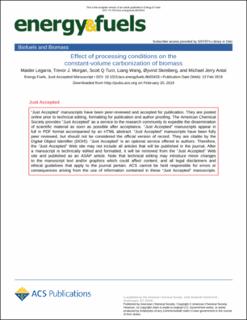| dc.contributor.author | Legarra, Maider | |
| dc.contributor.author | Morgan, Trevor | |
| dc.contributor.author | Turn, Scott | |
| dc.contributor.author | Wang, Liang | |
| dc.contributor.author | Skreiberg, Øyvind | |
| dc.contributor.author | Antal, Michael Jerry | |
| dc.date.accessioned | 2020-08-17T12:02:09Z | |
| dc.date.available | 2020-08-17T12:02:09Z | |
| dc.date.created | 2019-02-13T06:02:34Z | |
| dc.date.issued | 2019 | |
| dc.identifier.citation | Energy & Fuels. 2019, 33 (3), 2219-2235. | en_US |
| dc.identifier.issn | 0887-0624 | |
| dc.identifier.uri | https://hdl.handle.net/11250/2672626 | |
| dc.description.abstract | The effects of processing conditions (closed versus open reactor, pressure, temperature, soaking time, biomass loading, heating rate, and fuel particle size) on product yields and char properties from constant-volume carbonization are reported. Increasing the pretest, inert-gas, system pressure from 0 to 2.17 MPa did not significantly affect product yields or char proximate analysis results. Increasing the reaction time from 30 to 190 min and the temperature in the 300–550 °C range improved fixed-carbon contents and reduced volatile matter while maintaining or slightly increasing the fixed-carbon yields. In contrast to flash carbonization or traditional carbonization observations where larger particles produce beneficial effects, constant-volume carbonization produced equal or higher fixed-carbon contents and yields from smaller biomass particles. This offers possibilities that smaller-sized, lower-grade biomass can be used to produce high, fixed-carbon yield charcoal. Under certain processing conditions, the particulate biomass underwent a transient plastic phase transition that produced a single solid piece of final char. The roles of processing conditions in the formation of this transient plastic phase are also discussed. | en_US |
| dc.language.iso | eng | en_US |
| dc.publisher | ACS | en_US |
| dc.rights | Attribution-NonCommercial-NoDerivatives 4.0 Internasjonal | * |
| dc.rights.uri | http://creativecommons.org/licenses/by-nc-nd/4.0/deed.no | * |
| dc.title | Effect of processing conditions on the constant-volume carbonization of biomass | en_US |
| dc.type | Peer reviewed | en_US |
| dc.type | Journal article | en_US |
| dc.description.version | acceptedVersion | en_US |
| dc.rights.holder | ACS | en_US |
| dc.source.pagenumber | 2219-2235 | en_US |
| dc.source.volume | 33 | en_US |
| dc.source.journal | Energy & Fuels | en_US |
| dc.source.issue | 3 | en_US |
| dc.identifier.doi | 10.1021/acs.energyfuels.8b03433 | |
| dc.identifier.cristin | 1676732 | |
| dc.relation.project | Norges forskningsråd: 228726 | en_US |
| cristin.unitcode | 7548,70,0,0 | |
| cristin.unitname | Termisk energi | |
| cristin.ispublished | true | |
| cristin.fulltext | postprint | |
| cristin.qualitycode | 2 | |

